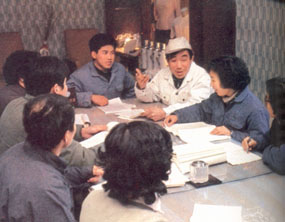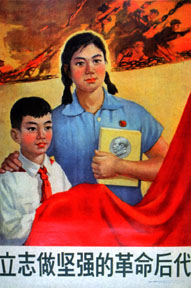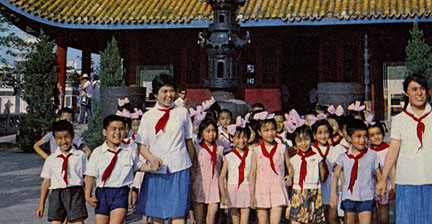|

Political leaders were not the only
ones to wear Mao suits. People of both genders, in all areas, and in all
different kinds of professions began wearing variations of the Mao suit
on a daily basis.
How do these outfits seem
different from those worn by the political leaders above? Do you think
these differences or the uniformity of the clothes of this period
reflected the social structure of China?
|
|
Factory cadres at a
meeting
| SOURCE:
China
Reconstructs
33.5 (May 1984): 42. Their caption: "The Shanghai Jinghua
Chemical Company guards against environmental pollution and is
beautifying its grounds, thanks in part to trade union
leadership." Photo Zhang Heling. |
|
 |
Why do you think some
of the men in these two scenes from the 1980s wear Mao jackets and
others do not?  |
|
Commuters in
Beijing
|
SOURCE:
China Reconstructs Vol 35, No. 1 (January 1986): 1.
|
|
Discussing building plans
| SOURCE:
China
Reconstructs
33.11 (Nov. 1984): 10. Their caption: Jinling graduates
assisting on the design for a hostel to be built by the Sun
Yat-sen Mausoleum administration. Photo by Zhou Youma. |
|

Children's clothing, while not generally called
Mao suits, could also indicate political allegiance. The red scarves seen
around the necks of the children in these two pictures indicate that
they are young pioneers. The scarves became important symbolic
objects to many of the children in this period.
The label on the poster to the left reads
"Set your mind on becoming a strong revolutionary successor." |
|
Poster
from 1965
| SOURCE:
Courtesy of the University of Westminster collection of Chinese
posters. |
|

|
|
Children on a field
trip to a temple, circa 1980
|
| SOURCE:
Cover of Fu Tao Yuan (Beijing: Zhongguo qingnian
chubanshe, March 1981). |
|
Move on to the Western-Style
Suit
|





